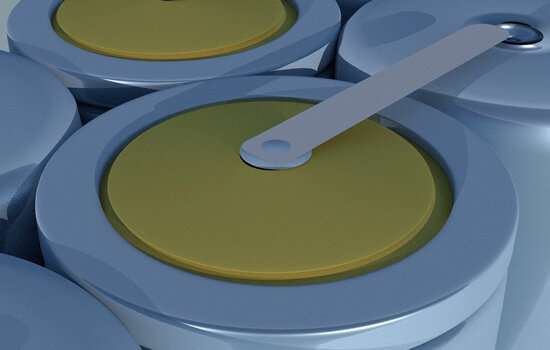New salts raise the bar for lithium ion battery technology

Lithium ion batteries are set to take a dominant role in electric vehicles and other applications in the near future—but the battery materials, currently in use, fall short in terms of safety and performance and are holding back the next generation of high-performance batteries.
In particular, the development of the electrolyte poses a key challenge for higher power batteries suitable for energy storage and vehicle applications.
At the Monash University School of Chemistry, scientists under the leadership of Professor Doug MacFarlane and Dr. Mega Kar working with local company Calix Ltd have come up with alternative solutions to this challenge with new chemistry.
"The lithium salt currently being used in lithium ion batteries is lithium hexafluorophosphate, which poses a fire and safety hazard as well as toxicity," said Professor MacFarlane.
"In smaller portable devices, this risk can be partially mitigated. However, in a large battery pack, such as electric vehicle and outdoor grid scale energy storage systems, the potential hazard is much intensified. Higher voltage and power batteries are also on the drawing board but cannot use the hexafluorophosphate salt. "
In research published in Advanced Energy Materials, the chemists describe a novel lithium salt which might overcome the challenges of electrolyte design and replace the hexafluorophosphate salt.
"Our aim has been to develop safe fluoroborate salts, which are not affected even if we expose them to air," said lead study author Dr. Binayak Roy, also from Monash University School of Chemistry.
"The main challenge with the new fluoroborate salt was to synthesize it with battery grade purity which we have been able to do by a recrystallisation process," he said.
"When put in a lithium battery with lithium manganese oxide cathodes, the cell cycled for more than 1000 cycles, even after atmospheric exposure, an unimaginable feat compared to the hyper-sensitive hexafluorophosphate salt."
According to Dr. Roy, when combined with a novel cathode material in a high voltage lithium battery, this electrolyte far outperformed the conventional salt. Moreover, the salt was found to be very stable on aluminum current collectors at higher voltages, as required for next generation batteries.
The research is a result of a collaborative effort within the Australian Research Council (ARC) Training Centre for Future Energy Storage Technologies (www.storenergy.com.au).
StorEnergy is a federally funded Industry Transformation Training Centre which aims to train and skill the next generation of workers within the Australia energy industry and promote industry-university collaboration.
StorEnergy Director Professor Maria Forsyth from Deakin University, said: "This is a wonderful example of how industry—university collaborations supported through government research funding can support Australia's leadership in next generation safe battery technologies."
The research was conducted in collaboration with Calix Ltd., a Victoria/NSW-based company that is producing high-quality manganese-based battery materials from Australian sourced minerals. The research will assist Calix to achieve its goal of large-scale fabrication of Australian-based Li-ion batteries, aiming for grid scale energy storage systems for roll out in Australia.
Dr. Matt Boot-Handford, General Manager for R&D at Calix said: "Calix is developing a platform technology to produce high-performance, cost-competitive battery materials in Australia. We are working closely with our research partners at Monash and Deakin through StorEnergy to support the development of electrolyte systems that are compatible with Calix's electrode materials. The superior electrochemical performance and stability demonstrated by the Monash team's new electrolyte system paired with Calix's lithium manganese oxide electrode material is an exciting and important milestone that brings us one step closer to making batteries featuring Calix next-generation electrode materials a commercial reality.
"In the near future we hope to turn these new anions into thermally stable, non-flammable liquid salts, making them beneficial for batteries operating at high temperatures," said Dr. Kar.
"With the current climate conditions, designing such battery technologies with safety and stability will be important in implementing a sustainable grid-scale energy solution in Australia."
More information: Binayak Roy et al, Lithium Borate Ester Salts for Electrolyte Application in Next‐Generation High Voltage Lithium Batteries, Advanced Energy Materials (2021). DOI: 10.1002/aenm.202101422
Journal information: Advanced Energy Materials
Provided by Monash University





















